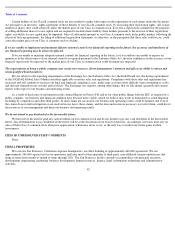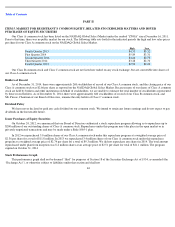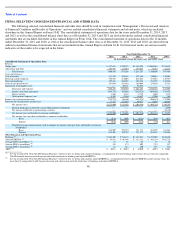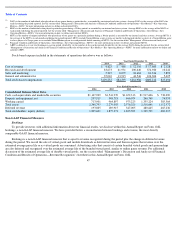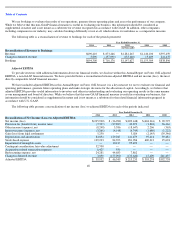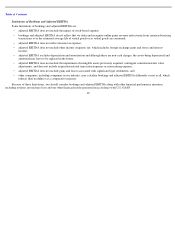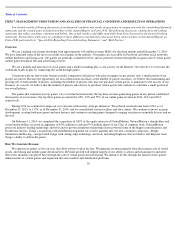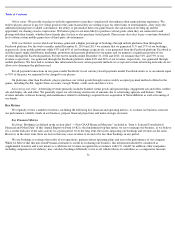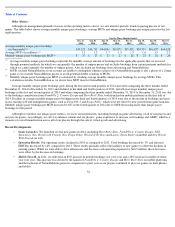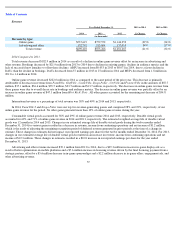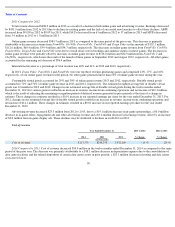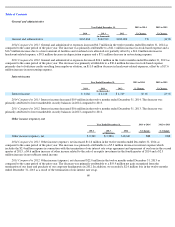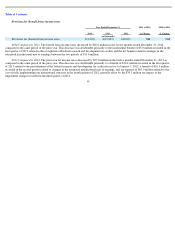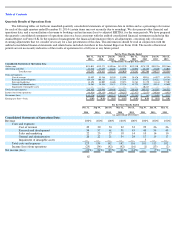Zynga 2014 Annual Report Download - page 55
Download and view the complete annual report
Please find page 55 of the 2014 Zynga annual report below. You can navigate through the pages in the report by either clicking on the pages listed below, or by using the keyword search tool below to find specific information within the annual report.
Table of Contents
Adjusted EBITDA. Adjusted EBITDA is a non-GAAP financial measure that we calculate as net income (loss), adjusted for provision for /
(benefit from) income taxes; other income (expense), net; interest income; gain (loss) from significant legal settlements; restructuring expense;
depreciation and amortization; impairment of intangible assets; stock-based expense; contingent consideration fair value adjustments;
acquisition-related transaction expenses, and change in deferred revenue. We believe that adjusted EBITDA provides useful information to
investors and others in understanding and evaluating our operating results in the same manner as our management and board of directors.
For a reconciliation of net income (loss) to adjusted EBITDA, see the section titled “—Non-GAAP Financial Measures” included in
“Item 6. Selected Consolidated Financial and Other Data” of this Annual Report on Form 10-K.
Key Operating Metrics
We manage our business by tracking several operating metrics: “DAUs,” which measure daily active users of our games, “MAUs,” which
measure monthly active users of our games, “MUUs,” which measure monthly unique users of our games, “MUPs,” which measure monthly
unique payers in our games, and “ABPU,” which measures our average daily bookings per average DAU, each of which is recorded by our
internal analytics systems. The numbers for these operating metrics are calculated using internal company data based on tracking the activity of
user accounts. We believe that the numbers are reasonable estimates of our user base for the applicable period of measurement; however, factors
relating to user activity and systems may impact these numbers.
DAUs . We define DAUs as the number of individuals who played one of our games during a particular day. Under this metric, an
individual who plays two different games on the same day is counted as two DAUs. Similarly, an individual who plays the same game on two
different platforms or social networks (e.g., Facebook.com, iPad, Android Phone, iPhone, etc.) on the same day would be counted as two DAUs.
Average DAUs for a particular period is the average of the DAUs for each day during that period. We use DAUs as a measure of audience
engagement.
MAUs. We define MAUs as the number of individuals who played a particular game in the 30-day period ending with the measurement
date. Under this metric, an individual who plays two different games in the same 30-day period is counted as two MAUs. Similarly, an
individual who plays the same game on two different platforms or social networks (e.g., Facebook.com, Zynga.com, iPad, Android Phone,
iPhone, etc.) in a 30-day period would be counted as two MAUs. Average MAUs for a particular period is the average of the MAUs at each
month-end during that period. We use MAUs as a measure of total game audience size.
MUUs. We define MUUs as the number of unique individuals who played any of our games on a particular platform in the 30-day period
ending with the measurement date. An individual who plays more than one of our games in a given 30-day period would be counted as a single
MUU. However, because we cannot always distinguish unique individuals playing on multiple platforms, a player playing on two different
platforms (e.g. web and mobile) in a given 30-day period may be counted as two MUUs. Because many of our players play more than one game
in a given 30-day period, MUUs are always lower than MAUs in any given time period. Average MUUs for a particular period is the average of
the MUUs at each month-end during that period. We use MUUs as a measure of total audience reach across our network of games.
MUPs . We define MUPs as the number of unique players who made a payment at least once during the applicable month through a
payment method for which we can quantify the number of unique payers, including payers from certain mobile games. MUPs does not include
payers who use certain payment methods for which we cannot quantify the number of unique payers. Because we cannot always distinguish
unique individuals playing on two different social networks, an individual who makes a payment on two different social networks in a given 30-
day period may be counted as two MUPs. MUPs are presented as an average of the three months in the applicable quarter. We use MUPs as a
measure of the number of unique players who made payments across our network of games each month.
52


